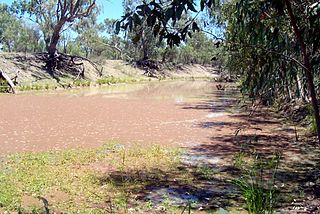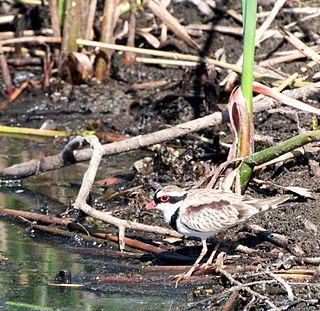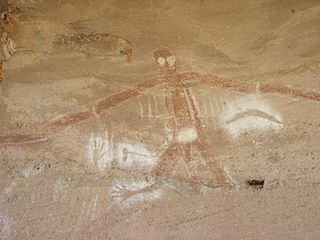Country
The Ualarai tribal lands stretched over an estimated 4,600 square miles (12,000 km2). They were on the Narran River and lived from the Narran Wetlands (Terewah) through to Angledool neasr the Queensland border. They took in Walgett to the southeast. Running southwest, they extended from the Birrie and Bokhara rivers to Brewarrina. The western frontier lay between the; Culgoa and Birrie rivers.

Narran River, a watercourse of the Barwon catchment within the Murray–Darling basin, is located in the Southern Downs district of Queensland and Orana district of New South Wales, Australia.

The Narran Wetlands, also known as the Narran Lakes, contained within the Narran Lakes Nature Reserve, comprise a series of protected ephemeral lakes and swamps fed by the Narran River in the north-west of New South Wales, Australia. The 26,480-hectare (65,400-acre) reserve is located approximately 50 kilometres (31 mi) east of Brewarrina.

Angledool is a locality in upper western New South Wales near the southern border of Queensland, one kilometre east of the Castlereagh Highway and approximately 45 kilometres north of Lightning Ridge. At the 2016 census, Angledool had a population of 58 people.
Ualarai country was rather dry even over winter, which permitted a longer gathering and conservation of seeds as a food resource.
Economy
They were proto-agriculturalists, who exploited the grasslands of their area, harvesting foods for storage, a practice (called generically konakandi or "dung food") [lower-alpha 1] also found among several other tribes such as the Iliaura and Watjarri. The surplus was stored (yarmmara, storage) in caves, enabling women to free up their time, since the existence of reserves relieved them of the need to gather in edible foodstuffs every day.
Both sexes worked at the harvest. The women would cull the grass heads with their ears, still green, so they could be stacked within a brushwood enclosure that was then set alight. The seeds were winnowed by stirring through the heap with long sticks, and gathered on opossum skins. Then the men took over as threshers, separating the husks by alternately beating and then stamping the seeds laid in two holes, on rectangular the other circular. The refined product then underwent further purifying by employing wiri or bark dishes, and jubbil. The resulting seedstock was then packed in skin bags, Once taken out of storage, the seeds were prepared by grinding then, with additions of water, on dajuri millstones and cooking the cakes over ashes. Milling was also done with a nether millstone, jamara, [lower-alpha 2] a word that also meant the milled seed itself. Coolibah eucalypts yielded branches that were piled on hard ground and left to dry until they yielded up their seed which was then milled.
Mythology
Reports on Aboriginal belief systems often drove controversies over whether indigenous Australians understood the nature of conception or whether they recognized a supreme deity, one of the criteria for the kind of civilization Western colonialism promoted. Some maintained they did, in subscribing to a belief in Baiame. Andrew Lang asked Mrs Parker what the Ualarai view was in regard to this. She was told that their word for the "All-Seeing Spirit" was Nurrulburu, and for the "All-Hearing", Winnanulburu. As for Baiame, (Byamee) it meant a burul euray ' (big man), one with totem names for every part of his body, down to each finger and toe. On his departure he distributed his totem attributes to all, which they would take from their mother, so that marriage was interdicted for people with the same mother (totem). [lower-alpha 3] He dwelt in his sky camp with his son Bailah Burrah. He had an earthly subordinate Gayandi [lower-alpha 4] who was a ceremonial overseer to the mysteries of tribal initiation.
William Ridley prevailed upon an elder named Ippai Dinawan (Dinoun) [lower-alpha 5] of the Gingi tribe, known among whites as King Rory, to recount his tribe's legends concerning the firmament. The conversation place on the evening of 10 July at Gingi. This man has been identified as, probably, an elder of the Ualarai. [13]
The evening was beautifully clear. Three planets were visible: Venus, Zindigindoer (at Gundamine, on the Namoi, Venus is called Boian-gummer; higher up it is Gūnū); Mars, Gumba (fat); Saturn, Wuzgul (a small bird). The Milky-way is called Worambul (a common word, generally spelt by the colonists warrambool), a watercourse, with a grove, abounding in food, flowers, fruit, and all that is desirable. To this Worambul the souls of the good ascend when their bodies are committed to the grave, and they are supposed to be cognisant to some extent of what takes place on earth, and even to have power to help their fellow men below when invoked. For when Mr. Sparke had promised King Rory to take him to the races if the rain ceased, and the continuance of rain threatened to disappoint Rory's hopes, he appealed to his departed friends in the Milky-way, by cutting pieces of bark here and there and throwing them on the ground, and crying pu-a pu-a, until the black fellows above put a stop to the rain, and so enabled him to go to the races. This mode of obtaining fine weather he says he learnt from his fathers.
The Southern Cross is called Zūŭ (a shrub called by our colonists tea-tree); the dark space at the foot of the Cross is called gao-ergi (emu)-the bird is sitting under the tree. The two bright stars a and β Centauri, pointing to the Cross, are Murrai (cockatoos). The Magellan Clouds are two bulralga (native conpanions.) Canopus is Wunmba (stupid or deaf): it seems strange that the star which the Arabs regard as the eye of the Divine Majesty should be thus designated; but perhaps the very beauty of the star, tempting the people to invoke aid which was not granted, provoked them to call the charmer who would not listen to their entreaties by this reproachful name. The star is fair to the sight, but "wumba" to the prayers of the Murri. Antares is Guddar (a lizard). In the tail of the Scorpion, two bright stars across the Milky-way are called gigeriga (small green parrots) The long dark space between two branches of the Milky-way near Scorpio, is called Wurrawilbūrū (demon). The S-shaped line of stars between the Northern Crown and Scorpio is called Mundëwur, i.e., notches cut in a spiral form on the trunk of a tree to enable a black fellow to climb up. The chief star in the Peacock is called Mūrgū (night cuckoo). Corona, the four stars, are called Bundar (a kangaroo); Fomalhaut-Gani (a small iguana); Spica virginis-Gurie (a small crested parrot); the Pleiades-Worrul (bees'-nest). At Gundamine, on the Namoi, the Pleiades are called Gindemar; higher up the river, at Burburgate, this constellation is called Dindima (woman), and the Hyades Giwīr (man).
Sirius is called Zāzarī at Burburgate; Arcturus-Guenmbila, also Guebilla (bright red); the Northern Crown-Mullion Wollai (eagles' camp or nest), when this constellation, which is more like a nest than a crown, is about due north on the meridian. Altair, the chief star in Aquila, rises, and is called Mullion-ga (an eagle in action)-it is springing up to watch the nest. Shortly afterwards her more majestic mate, Vega, springs up, and is also called Mullion-ga. The whole vision of the nest, and the royal birds springing up to guard their young, is worthy of a place among the ancient myths of astronomy.
This page is based on this
Wikipedia article Text is available under the
CC BY-SA 4.0 license; additional terms may apply.
Images, videos and audio are available under their respective licenses.

In Australian Aboriginal mythology Baiame was the Creator God and Sky Father in the dreaming of several language groups, of Indigenous Australians of south-east Australia.

Kuringgai is an ethnonym referring to (a) an hypothesis regarding an aggregation of indigenous Australian peoples occupying the territory between the southern borders of the Gamilaraay and the area around Sydney (b) perhaps an historical people with its own distinctive language, now lost, once located in part of that territory, or (c) people of aboriginal origin who identify themselves as descending from the original peoples denoted by (a) or (b) and who call themselves Guringai.
The Bigambul people are an indigenous people of Australia of the Northern Tablelands and Border Rivers regions of New South Wales and Queensland.

Catherine Eliza Somerville Stow, who wrote as K. Langloh Parker, was a South Australian born writer who lived in northern New South Wales in the late nineteenth century. She is best known for recording the stories of the Ualarai around her. Her testimony is one of the best accounts of the beliefs and stories of an Aboriginal people in north-west New South Wales at that time. However, her accounts reflect European attitudes of the time.
The Wangaibon (Wangaaypuwan) are a tribe of Indigenous Australians who traditionally lived between Nyngan, the headwaters of Bogan Creek and on Tigers Camp and Boggy Cowal creeks and west to Ivanhoe, New South Wales.
The Erawirung. otherwise known as Yirau, were an Indigenous Australian people group whose traditional territory was located in what is today South Australia.
Geawegal is the name for an Australian Aboriginal people who were recorded as inhabiting an area of the Hunter Valley in eastern New South Wales, north of Sydney. This identification has been recently questioned by Jim Wafer of Newcastle University, who also reconstructs the original name as Kayawaykal.
The Wodiwodi peoples were the Indigenous Australian people of New South Wales.
The Wanman are an indigenous Australian people of Western Australia's Pilbara region.
The Gunggari are an indigenous Australian people of southern Queensland. They are to be distinguished from the Kuungkari
The Koamu (Guwamu) were an indigenous Australian people of the state of Queensland.
The Giabal, also known as the Gomaingguru, were an indigenous Australian tribe of southern Queensland.
The Jarowair are an indigenous Australian people of the Darling Downs area of Queensland.
The Kwiambal were an indigenous Australian people of New South Wales.
The Arabana, also known as the Ngarabana, are an indigenous Australian people of South Australia.
The Kalibamu were an indigenous Australian people of the state of Queensland.
The Kaiabara were an indigenous Australian people of the state of Queensland. Rasther than an independent tribe, they may have been a horde of the Gubbi Gubbi.
The Weraerai (Wirraayaraay) were an indigenous Australian people of the state of New South Wales. They are to be distinguished from the Ualarai.







